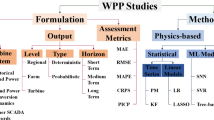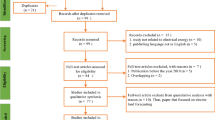Abstract
With the increasing penetration of wind power in renewable energy systems, it is important to improve the accuracy of wind speed prediction. However, wind power generation has great uncertainties which make high-quality interval prediction a challenge. Existing multi-objective optimization interval prediction methods do not consider the robustness of the model. Thus, trained models for wind speed interval prediction may not be optimal for future predictions. In this paper, the prediction interval coverage probability, the prediction interval average width, and the robustness of the model are used as three objective functions for determining the optimal model of short-term wind speed interval prediction using multi-objective optimization. Furthermore, a new Stochastic Sensitivity for Prediction Intervals (SS_PIs) is proposed in this work to measure the stability and robustness of the model for interval prediction. Using wind farm data from countries on two different continents as case studies, experimental results show that the proposed method yields better prediction intervals in terms of all metrics including prediction interval coverage probability (PICP), prediction interval normalized average width (PINAW) and SS_PIs. For example, at the prediction interval nominal confidence (PINC) of 85%, 90% and 95%, the proposed method has the best performance in all metrics of the USA wind farm dataset.




Similar content being viewed by others
Abbreviations
- AI:
-
Artificial intelligence
- ANN:
-
Artificial neural network
- ARIMA:
-
Autoregressive integrated moving average model
- ARMA:
-
Autoregressive moving average model
- BP:
-
Back propagation
- EEMD:
-
Electromagnetic mode decomposition
- EMD:
-
Empirical mode decomposition
- GRU:
-
Gated recurrent unit
- ICEEMDAN:
-
Improved ceemdan
- LSTM:
-
Long short-term memory
- LUBE:
-
Lower upper bound estimation
- MLP:
-
Multilayer perceptron
- MOGA:
-
Multi-objective genetic algorithm
- MSE:
-
Mean square error
- NSGA-III:
-
Non-dominated sorting genetic algorithm-III
- NWP:
-
Numerical weather prediction
- PICP:
-
Prediction interval coverage probability
- PINAW:
-
Prediction interval normalized average width
- PINC:
-
Prediction interval nominal confidence
- PIs:
-
Prediction intervals
- RNN:
-
Recurrent neural network
- SS_PIs:
-
Stochastic sensitivity for prediction intervals
- SSMOO:
-
Stochastic sensitivity-based multi-objective optimization
- WNN-PICEA-g:
-
Wavelet neural network—preference inspired co-evolutionary algorithm—goal vectors
References
Shrivastava NA, Kunal L, Panigrahi BK (2017) A multiobjective framework for wind speed prediction interval forecasts. Renew Energy 87(2):903–910
Zhang Y, Pan G, Zhao Y, Li Q, Wang F (2020) Short-term wind speed interval prediction based on artificial intelligence methods and error probability distribution. Energy Convers Manag 224:113346
Lai CS, Locatelli G (2021) Are energy policies for supporting low-carbon power generation killing energy storage? J Clean Prod 280:124626
Khodayar M, Kaynak O, Khodayar M (2017) Rough deep neural architecture for short-term wind speed forecasting. IEEE Trans Ind Inform 13(6):2770–2779
Zhang Y, Zhao Y, Pan G, Zhang J (2020) Wind speed interval prediction based on Lorenz disturbance distribution. IEEE Trans Sustain Energy 11(2):807–816
Chai S, Xu Z, Lai LL, Wong KP (2015) An overview on wind power forecasting methods. In: Proceedings of the international conference on machine learning and cybernetics, IEEE, Guangzhou, China
Zhang H-T, Chang K, Zhang H, Lai LL (2016) A novel probabilistic approach for evaluating fault ride-through capability of wind generation. In: International conference on machine learning and cybernetics, Jeju, Korea, 9–12 July
Ssekulima EB, Anwar MB, Al-Hinai A, El-Moursi MS (2016) Wind speed and solar irradiance forecasting techniques for enhanced renewable energy integration with the grid: a review. IET Renew Power Gener 10(7):885–989
Yin H, Dong Z, Chen Y, Ge J, Lai LL, Vaccaro A, Meng A (2017) An effective secondary decomposition approach for wind power forecasting using extreme learning machine trained by crisscross optimization. Energy Convers Manag 150:108–121
Zhang J, Draxl C, Hopson T, Monache LD, Vanvyve E, Hodge B (2015) Comparison of numerical weather prediction based deterministic and probabilistic wind resource assessment methods. Appl Energy 156:528–541
Zhang Z, Ye L, Qin H, Liu Y, Wang C, Yu X, Yin X, Li J (2019) Wind speed prediction method using shared weight long short-term memory network and Gaussian process regression. Appl Energy 247:270–284
Naik J, Satapathy P, Dash PK (2018) Short-term wind speed and wind power prediction using hybrid empirical mode decomposition and kernel ridge regression. Appl Soft Comput 70:1167–1188
Erdem E, Shi J (2011) ARMA based approaches for forecasting the tuple of wind speed and direction. Appl Energy 88(4):1405–1414
Yunus K, Thiringer T, Chen P (2016) ARIMA-based frequency-decomposed modeling of wind speed time series. IEEE Trans Power Syst 31(4):2546–2556
Li S, Wang P, Goel L (2015) Wind power forecasting using neural network ensembles with feature selection. IEEE Trans Sustain Energy 6(4):1447–1456
Luo X et al (2018) Short-term wind speed forecasting via stacked extreme learning machine with generalized correntropy. IEEE Trans Ind Inf 14(11):4963–4971
Jahangir H, Golkar MA, Alhameli F, Mazouz A, Ahmadian A, Elkamel A (2020) Short-term wind speed forecasting framework based on stacked denoising auto-encoders with rough ANN. Sustain Energy Technol Assess 38:100601
Huang NE, Shen Z, Long SR, Wu ML, Shih HH, Zheng Q et al (1998) The empirical mode decomposition and Hilbert spectrum for nonlinear and nonstationary time series analysis. Proc R Soc Lond A 454:903–995
Wu Z, Huang NE (2009) Ensemble empirical mode decomposition: A noise-assisted data analysis method. Adv Adapt Data Anal 01(01):1–41
Liu Z, Jiang P, Zhang L, Niu X (2020) A combined forecasting model for time series: application to short-term wind speed forecasting. Appl Energy 259:114137
Ahmadi G, Teshnehlab M (2017) Designing and implementation of stable sinusoidal rough-neural identifier. IEEE Trans Neural Netw Learn Syst 28(8):1774–1786
Niu X, Wang J (2019) A combined model based on data preprocessing strategy and multi-objective optimization algorithm for short-term wind speed forecasting. Appl Energy 241:519–539
Shi Z, Liang H, Dinavahi V (2018) Direct interval forecast of uncertain wind power based on recurrent neural networks. IEEE Trans Sustain Energy 9(3):1177–1187
Kabir HMD, Khosravi A, Hosen MA, Nahavandi S (2018) Neural network-based uncertainty quantification: a survey of methodologies and applications. IEEE Access 6:36218–36234
Hong T, Fan S (2016) Probabilistic electric load forecasting: a tutorial review. Int J Forecast 32(3):914–938
Wan C, Wang J, Lin J, Song Y, Dong ZY (2018) Nonparametric PIs of wind power via linear programming. IEEE Trans Power Syst 33(1):1074–1076
Yan J et al (2017) Hybrid probabilistic wind power forecasting using temporally local Gaussian process. IEEE Trans Sustain Energy 7(1):87–95
Wang Z et al (2018) Short-term probabilistic forecasting for regional wind power using distance-weighted kernel density estimation. IET Renew Power Gener 12(15):1725–1732
Khosravi A, Nahavandi S, Creighton D, Atiya AF (2011) Lower upper bound estimation method for construction of neural network-based PIs. IEEE Trans Neural Netw 22(3):337–346
Quan H, Srinivasan D, Khosravi A (2014) Short-term load and wind power forecasting using neural network-based PIs. IEEE Trans Neural Netw Learn Syst 25(2):303–315
Hu M et al (2017) A novel multi-objective optimal approach for wind power interval prediction. Energies 10(4):419
Ak R, Vitelli V, Zio E (2015) An interval-valued neural network approach for uncertainty quantification in short-term wind speed prediction. IEEE Trans Neural Netw Learn Syst 26(11):2787–2800
Kavousi-Fard A, Khosravi A, Nahavandi S (2016) A new fuzzy-based combined prediction interval for wind power forecasting. IEEE Trans Power Syst 31(1):18–26
Wan C, Xu Z, Pinson P (2013) Direct interval forecasting of wind power. IEEE Trans Power Syst 28(4):4877–4878
Wan C, Xu Z, Pinson P, Dong ZY, Wong KP (2014) Optimal prediction intervals of wind power generation. IEEE Trans Power Syst 29(3):1166–1174
Hosen MA, Khosravi A, Nahavandi S, Creighton D (2015) Improving the quality of prediction intervals through optimal aggregation. IEEE Trans Ind Electron 62(7):4420–4429
Zhang G, Wu Y, Wong KP, Xu Z, Dong ZY, Iu HHC (2015) An advanced approach for construction of optimal wind power prediction intervals. IEEE Trans Power Syst 30(5):2706–2715
Li C, Tang G, Xue C, Saeed A, Hu X (2019) Short-term wind speed interval prediction based on ensemble GRU model. IEEE Trans Sustain Energy. https://doi.org/10.1109/TSTE.2019.2926147
Yeung DS, Li J, Ng WWY, Chan PPK (2016) MLPNN training via a multiobjective optimization of training error and stochastic sensitivity. IEEE Trans Neural Netw Learn Syst 27(5):978–992
Deb K, Jain H (2014) An evolutionary many-objective optimization algorithm using reference-point-based nondominated sorting approach part I: solving problems with box constraints. IEEE Trans Evol Comput 18(4):577–601
Jain H, Deb K (2014) An evolutionary many-objective optimization algorithm using reference-point based nondominated sorting approach part II: handling constraints and extending to an adaptive approach. IEEE Trans Evol Comput 18(4):602–622
Khosravi A, Nahavandi S, Creighton D (2010) Construction of optimal prediction intervals for load forecasting problems. IEEE Trans Power Syst 25(3):1496–1503
Jin Y, Sendhoff B (2008) Pareto-based multiobjective machine learning: an overview and case studies. IEEE Trans Syst Man Cybern Part C (Appl Rev) 38(3):397–415
[Online]. http://www.nrel.gov/index.html. Accessed 3 Aug 2019
[Online]. http://www.sotaventogalicia.com/en/real-time-data/historical. Accessed 21 Oct 2019
Shi Z, Liang H, Dinavahi V (2018) Wavelet neural network based multiobjective interval prediction for short-term wind speed. IEEE Access 6:63352–63365
Acknowledgements
This work is in part supported by National Natural Science Foundation of China under Grants 61876066 and 61572201, in part by Guangdong Province Scienceand Technology Plan Project (Collaborative Innovation and Platform Environment Construction) 2019A050510006, in part by Brunel University London BRIEF Funding, UK and in part by the Education Department of Guangdong Province: New and Integrated Energy System Theory and Technology Research Group [Project Number 2016KCXTD022].
Author information
Authors and Affiliations
Corresponding authors
Additional information
Publisher's Note
Springer Nature remains neutral with regard to jurisdictional claims in published maps and institutional affiliations.
Rights and permissions
About this article
Cite this article
Chen, X., Lai, C.S., Ng, W.W.Y. et al. A stochastic sensitivity-based multi-objective optimization method for short-term wind speed interval prediction. Int. J. Mach. Learn. & Cyber. 12, 2579–2590 (2021). https://doi.org/10.1007/s13042-021-01340-6
Received:
Accepted:
Published:
Issue Date:
DOI: https://doi.org/10.1007/s13042-021-01340-6




